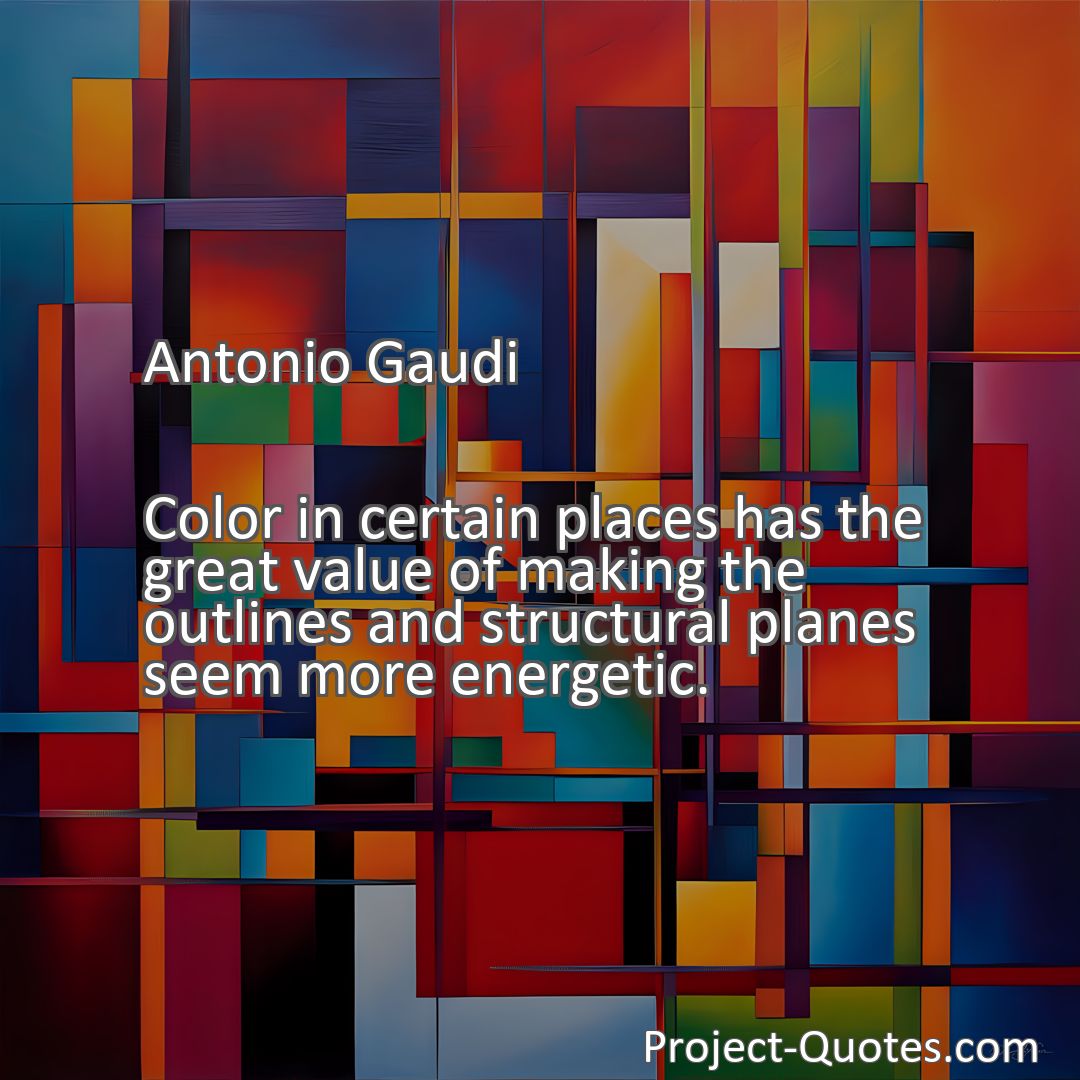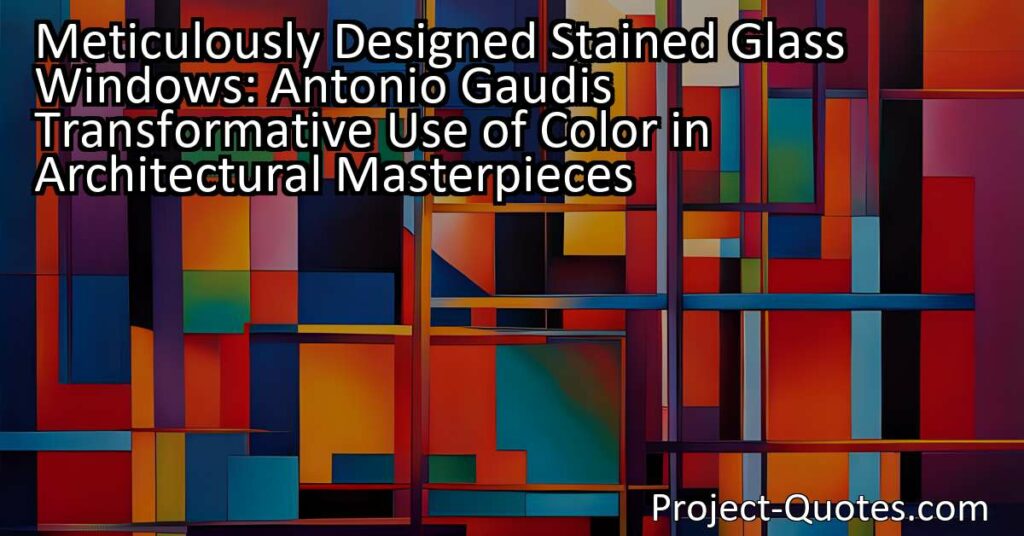Color in certain places has the great value of making the outlines and structural planes seem more energetic.
Antonio Gaudi
Antonio Gaudi, a brilliant Spanish architect, utilized color in his meticulously designed stained glass windows to transform the perception of space and bring energy and life to his architectural masterpieces. From the vibrant mosaic of colors at the Sagrada Familia’s Nativity Façade to the somber tones of the Passion Façade, Gaudi strategically incorporated hues that enhanced specific features and created a captivating visual experience for viewers. Gaudi’s skillful use of color continues to inspire architects and artists today, highlighting the profound impact that color can have on our built environment.
Table of Contents
Meaning of Quote – Color in certain places has the great value of making the outlines and structural planes seem more energetic.
Color plays a significant role in our lives, whether we realize it or not. It has the power to evoke emotions, create moods, and add vibrancy to our surroundings. One who fully understood and utilized the potential of color was the brilliant Spanish architect Antonio Gaudi. Through his distinctive architectural style, Gaudi demonstrated how color could transform the perception of space and imbue it with energy and life.
Gaudi, born in 1852 in Reus, Catalonia, Spain, is celebrated for his unique and unconventional approach to architecture. His works, which include the world-renowned Sagrada Familia and Casa Batlló in Barcelona, are characterized by their fluid forms, intricate details, and stunning use of color. Gaudi firmly believed that color had the extraordinary ability to enhance the visual impact of architectural structures, making them appear more dynamic and lively.
The quote “Color in certain places has the great value of making the outlines and structural planes seem more energetic” perfectly encapsulates Gaudi’s philosophy on the significance of color. In his architectural designs, Gaudi strategically incorporated color to emphasize specific features and highlight the underlying structure. By doing so, he created an exceptional visual experience for viewers, captivating their attention and stimulating their imagination.
To understand the impact of color on architectural structures, it is essential to explore how Gaudi utilized this medium in his iconic works. Let us focus on one of his most famous creations, the Sagrada Familia, a monumental basilica that has been under construction for over a century.
As one gazes upon the Sagrada Familia, the first thing that strikes the eye is its towering presence and intricate façade. However, it is the clever use of color that truly brings this masterpiece to life. Gaudi understood that color could accentuate the various architectural elements, making them appear more prominent and dynamic. He carefully selected hues that complemented one another, creating a harmonious composition that was pleasant to the eye.
For instance, the vibrant mosaic of colors on the Nativity Façade, a section of the Sagrada Familia dedicated to the birth of Jesus, adds a sense of joy and celebration. Gaudi’s use of warm tones such as reds, yellows, and oranges brings a sense of liveliness to the figures and motifs decorating the façade. It is as if the colors themselves are dancing and conveying the exuberance of the scene they depict.
Similarly, the Passion Façade, dedicated to the crucifixion and resurrection of Jesus, exhibits a completely different color palette. Gaudi purposefully chose cooler, somber tones like blues and greens to evoke a sense of solemnity and contemplation. These colors lend an air of tranquility and introspection to the façade, reflecting the emotional intensity of the depicted scenes.
Beyond the façades, color continues to shape the experience within the Sagrada Familia. As light penetrates through the meticulously designed stained glass windows, it interacts with the architectural elements, casting vibrant hues across the interior space. Gaudi believed that the interplay between natural light and color was essential in creating a captivating atmosphere. The colorful glow that engulfs the nave fills the space with an ethereal aura, inviting visitors to experience a sense of spiritual transcendence.
Gaudi’s skillful use of color extends beyond the Sagrada Familia and can be seen in his other architectural projects as well. Casa Batlló, a house on Passeig de Gracia in Barcelona, exemplifies Gaudi’s ability to transform a mundane building into a work of art through the strategic application of color.
The façade of Casa Batlló is adorned with mosaic-tiled ceramic disks, resembling fish scales or even an iridescent dragon’s skin. Gaudi wisely selected a range of blue hues for this section, providing a sense of movement and fluidity to the building. As the light plays upon the tiles, an ever-changing display of shadows and reflections dances across the surface, mesmerizing anyone who beholds it.
Inside Casa Batlló, Gaudi continued his exploration of color through the innovative design of the central lightwell known as the “Pati de Llum.” This extraordinary space utilizes shades of blue and turquoise in a gradient pattern, creating a dynamic visual effect. As one ascends the staircase, the colors transform, symbolizing the transition from earthly to celestial realms. Gaudi’s deliberate choice of color adds a magical dimension to the experience of moving through the building, making it a journey of beauty and wonder.
In conclusion, Antonio Gaudi’s quote “Color in certain places has the great value of making the outlines and structural planes seem more energetic” shines a light on the transformative power of color within architecture. Gaudi, an architectural genius, understood that color had the ability to enhance the vitality of structural elements, evoking different emotions and creating unique experiences. Whether through the vivid mosaics of the Sagrada Familia or the enchanting chromatic interplay of Casa Batlló, Gaudi used color as a language to communicate energy, dynamism, and even spirituality. His innovative approach continues to inspire architects and artists today, reminding us of the profound impact that color can have on our built environment.
I hope this quote inspired image brings you hope and peace. Share it with someone who needs it today!


